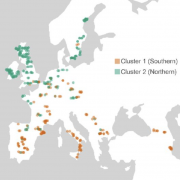bioRxiv: Drought selects on plants and also their microbiomes
Drought selection on Arabidopsis populations and their microbiomes
Talia L. Karasov (2022) bioRxiv 487684 doi.org/10.1101/2022.04.08.487684
Microbes affect plant health, stress tolerance1 and life history2. In different regions of the globe, plants are colonized by distinct pathogenic and commensal microbiomes, but the factors driving their geographic variation are largely unknown3. We identified and measured the core leaf microbiome of Arabidopsis thaliana in its native range, from almost 300 populations across Europe. Comparing the distribution of the approximately 500 major bacterial phylotypes, we discovered marked, geography-dependent differences in microbiome composition within A. thaliana and between A. thaliana and other Brassicaceae, with two distinct microbiome types segregating along a latitudinal gradient. The differences in microbiome composition mirror the spatial genetics of A. thaliana, with 52-68% of variance in the first two principal coordinates of microbiome type explained by host genotype. Microbiome composition is best predicted by drought-associated metrics that are well known to be a major selective agent on A. thaliana populations. The reproducible and predictable associations between specific microbes and water availability raise the possibility that drought not only directly shapes genetic variation in A. thaliana, but does so also indirectly through its effects on the leaf microbiome.




